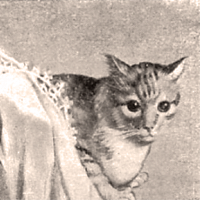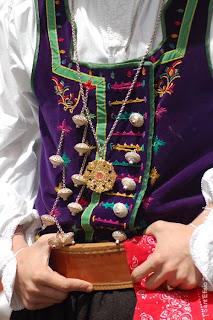Summer always has me thinking of learning something new and I usually decide to tackle a technique that I haven't tried yet. This summer though I am thinking of getting to know some techniques a little better instead of taking on a new one.
Lots of Italians head to Sardinia for their summer holidays and since I can't do that, I've been revisiting some of their needlework techniques in the unusually sunny weather we are having at home. There is nothing better than sunlight for visibility when stitching so I've been out on my deck under my own ombrellone.
In the spring of 2011 I visited Sardinia and spent some time getting to know a few Sardinian needlework techniques like Puntu Vanu, a type of smocking and two techniques that are specifically from Teulada: Punt'e Nù and Punt'a Brodu.
I'm running into all kinds of difficulties not the least of which is lack of good eyesight!
Puntu Vanu is usually executed on percale cotton fabric as it is traditionally worked into a shirt or blouse. I honestly tried to perform an evenly spaced running stitch line on a piece of percale but I couldn't see well enough to do more than a few stitches a day without hurting my eyes with the amount of magnification I needed so I switched to a piece of Sotema Batiste cotton.
Using Rosalba Lecca and Ebe Ciampalini's book, I chose a simple heart pattern and then withdrew one ground fabric thread into which I stitched my first running stitch line.
 |
| The first stitching line of my Puntu Vanu piece. |
It was tough going as even the fabric count on the Batiste cotton is quite high. Eventually I figured out that if I wrapped my finger in piece of dark leather-like cloth and laid the work over it, I could see relatively well and the stitches went more quickly (the leather-like cloth was sent to me by the lovely Elizabeth Prickett for use when making Ruskin Lace. Unfortunately Elizabeth has since passed away so I cannot ask her for a supplier or even what the cloth is made of. If you really want to know, you could try contacting the webstore).
As Puntu Vanu is a kind of smocking, the strip of embroidery must be long as it will be pulled so that the fabric bunches up to form the pattern. Roughly a 36 inch strip of the Batiste of this thread count will produce a 12 inch piece of embroidery. I'll update you as I stitch more.
 |
| Photo from: Luoghi e Volti del Punto Filza |
For my Punt'e Nù practise, I decided to make a bookmark using some of the colours found on the traditional Teulada man's costume.
I took some patterns from this blog where you can also find the instructions on how to execute this embroidery. While you're there search Puntu Vanu, Punt'e Nù and Punt'a Brodu for some great photos!
I think I'll trim my fringe down a bit more. This was made on 28ct Jubilee cotton fabric using DMC no. 8 Pearl Cotton:
 |
| Punt'e Nù stitching |
And for Punt'a Brodu, I've taken part of a pattern off of a lovely vase painted by Marilena Ledda that I saw while in Sardinia in 2011:
 |
| The work of artist Marilena Ledda |
I'm still trying to perfect my stitching on this pattern that I proposed for the EGA magazine Needlearts, June 2013. In the magazine, I did the pattern using embroidery floss but here I've done it using DMC no. 80 tatting thread. I still need a LOT of practise!
I hope you have enjoyed "travelling" to Sardinia with me. As far as I know there are no instructional books on Punt'e Nù or Punt'a Brodu. The instructions (which start in Febbraio 2010) for Punt'e Nù on the blog I mentioned above are quite good - give them a try! The only book I know of on Puntu Vanu is the one I mentioned above.








































